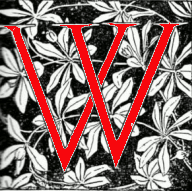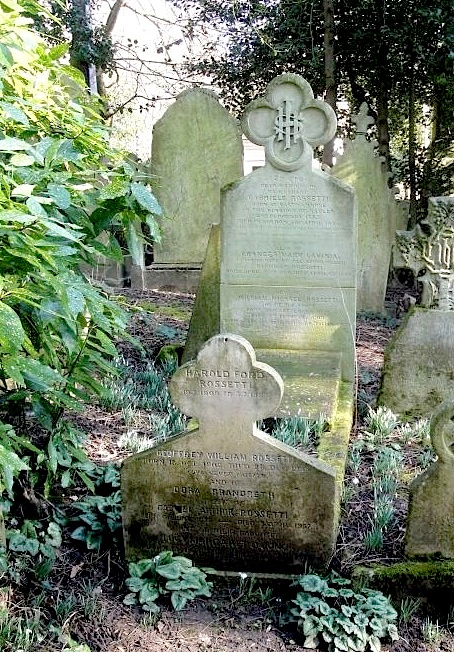
illiam Michael Rossetti is a major figure in the history of Pre-Raphaelitism, best known as an art critic, writer, and literary editor. He was born in London on 25 September 1829, the son of the immigrant Italian poet and scholar Gabriele Rossetti, and his wife Frances Lavinia Polidori. William was the third of the four Rossetti children, a year younger than his more famous older brother Dante Gabriel. The two Rossetti brothers attended King's College School until 1841 when Gabriel left to take up his art studies at Sass's Academy. William continued until February 1845 when his father's increasing blindness and failing health forced him to quit school at age fifteen and become a clerk in the Excise Office at £80 a year. He thus became the main financial support for the entire Rossetti family. Despite this, he continued his literary pursuits and was the first of the Rossetti children to have a poem published when his "In the Hill-Shadow" appeared in The Athenaeum in October 1848. In that same month the Pre-Raphaelite Brotherhood was founded and William was appointed Secretary. He kept the PRB Journal from 1849 to 1855 and was editor of their literary magazine The Germ that published four issues in 1850. His book reviews for The Germ marked the beginning of his long career as a literary critic.
William also wrote art criticism, initially for The Critic, and from November 1850 until 1878 for The Spectator. William was the chief art critic for The Academy from 1869-78 and was also the British correspondent for the American art publication The Crayon that was published from 1855-61. He also wrote art criticism at various times for The Saturday Review, Fraser's Magazine, The London Review, The Edinburgh Weekly Review, The Fine Arts Quarterly Review, The Pall Mall Gazette, and The Chronicle. William's reviews were highly regarded at the time. George Du Maurier, in a letter of June 1863 to his friend Thomas Armstrong, commented: "I think he's the only critic who's not a hack and whose opinions are genuine & felt and strange to say he appears to me to have wonderfully little party feeling considering his bringing up & associations" (Du Maurier, Letters, 207).
In 1857-58 William acted as secretary for the Exhibition of Modern British Art that toured America. In 1858 he became a member of the Hogarth Club. In 1869 he was appointed Senior Assistant Secretary to the Inland Revenue Board. In 1874 he married Lucy Madox Brown, the daughter of his old friend Ford Madox Brown. In 1894 William retired from the Inland Revenue Board, although he continued to serve as an estate-duty advisor for the board until 1905, travelling all over the country to assess art works for estate duty. After his retirement William compiled and edited many invaluable books on his brother Dante Gabriel, his sister Christina, and on the Pre-Raphaelite Brotherhood. He was a major contributor to the 1911 edition of the Encyclopedia Britannica, primarily writing about Italian Old Masters. He died in London on February 5, 1919 and his ashes were buried in the Rossetti family grave at Highgate Cemetery.

The family grave in Highgate Cemetery: William's inscription is the lowest of the three on the headstone.
When the Pre-Raphaelite Brotherhood was founded in October 1848 William was the only member not training to become a professional artist. He did have some artistic training, however. As boys he and Dante Gabriel had taken up drawing and writing poetry together. At King's College School he took lessons from the drawing master John Sell Cotman. During the days of the Pre-Raphaelite Brotherhood, William continued to draw after his work in the Excise Office. In his Reminiscences, he recalled that the brothers Lowes and Robert Dickinson, "Towards 1849 ... promoted the formation of a drawing-class in Maddox Street, Regent Street, and I joined it for some little while. My brother thought rather well of my drawings from the life: I was always conscious however of their being stiff and ungenial, and never deceived myself into thinking that I possess an artistic aptitude worth developing. This was not the only drawing-class that I joined; there was one, for instance, set going by Thomas Seddon. I worked with moderate diligence and a result less than moderate, and finally, still youthful, I dropped the experiment" (139). The architect J. P. Seddon recalled how his brother Thomas had organized a drawing school in Camden Town over the family's furniture works in Gray's Inn Road "to provide for his friends, amongst whom were all the Pre-Raphaelites, facilities for studying the figure from life; and the occasion of their meetings for that purpose were usually prolonged as social gatherings, wherein much animated discussion took place upon artistic subjects" (Darby, Seddon, 13). It was here, close to the end of 1849, that William first met artists like George Price Boyce and John Richard Clayton. During mid-August 1849 William also joined his brother in drawing fairly regularly from life models at Leigh's Academy in Newman Street. In a letter to F. G. Stephens, Henry Tamworth Wells recalled "In the summer of 1849 Dante and Wm Rossetti, Lowes Dickinson and myself had nude models in my studio at the back of Bond Street" (Bradbury 15). Even as late as 1857 William attended Ruskin's drawings class at the Working Men's College after office hours at the Excise Office.



Left to right: (a) Portrait of Frederic George Stephens. (b) Portrait of William Holman Hunt. (c) Portrait of John Everett Millais
William Michael Rossetti was therefore not totally without an artistic education and fortunately some of his sketches still exist. During his training William undertook artistic exercises, made designs, did copies of other works, and most notably did portraits. Thirlwell has commented: "William's small clutch of surviving portraits - about a dozen - all exhibit his genuine human compassion, his sense of beauty even in plainness, his clear-sighted lack of sentimentality ... William's drawings are far more numerous and more varied than Pre-Raphaelite commentators have dared to discover or admit. They are significant because they show the connoisseur reviewer was, in his early days at least, also a practising artist" (115, 121). William's best works are definitely his portrait drawings in pencil and pen and ink, particularly those of his family and of his artist friends within the Pre-Raphaelite circle. Thirlwell has noted, "They bear witness to his genuine response to individual characters as well as to technical expertise" (106). While many tend to be laboured and rather amateurish others are really quite skillful. Some of his portrait drawings were made in conjunction with the drawings the PRB executed of each other on 12 April 1853 to send to Thomas Woolner in Australia. In a letter of 7 May 1853 to William Bell Scott, D. G. Rossetti wrote, "William did the whole lot of us in his striking style" (letter 53.29, p. 256). While not all of these drawings appear to survive, probably the best is his drawing of the young John Everett Millais, now in a private Australian collection. Another of his best drawings is a pen-and-ink sketch made of Holman Hunt that is dated c.1854. If this particular drawing was indeed made c.1854 it must have been executed in early January in connection with Hunt's impending departure on January 13 on his first journey to the Middle East. This is a surprisingly accomplished portrait drawing of Hunt displaying great economy of means and a deft touch. The portraits of his mother Frances and his sister Christina were drawn on June 22, 1853 during a visit to Frome where they were running a school.
Although William did not have the talent required to become a professional artist, the insights he gained into the creative process during his artistic training were of great value to him during his later career as an art critic. Because of his involvement with the Pre-Raphaelite movement William had gained both practical and theoretical knowledge of contemporary art that would prove crucial to him in his role as an art reviewer.
Biographical Material
Drawings by William Michael Rossetti
- Portrait of Frederic George Stephens
- Portrait of William Holman Hunt
- Portrait of Frances Rossetti, the Artist's Mother
- Portrait of Christina Rossetti, the Artist's Sister
- Portrait of John Everett Millais
Reviews
Bibliography
Bradbury, Sue. Joanna, George and Henry. A Pre-Raphaelite Tale of Art, Love and Friendship. Woodbridge, Suffolk: The Boydell Press, 2012.
Darby, Michael. John Pollard Seddon. London: Victoria and Albert Museum, 1983.
Du Maurier, George. The Young George du Maurier, A Selection of His Letters, 1860-1867. Ed. Daphne Du Maurier. London: Peter Davies, 1951.
Peattie, Roger W. "William Michael Rossetti's Art Notices: In the Periodicals, 1850-1878: An Annotated Checklist." Victorian Periodicals Newsletter, 8 (1975): 7992.
Rossetti, Dante Gabriel. The Correspondence of Dante Gabriel Rossetti. The Formative years 1835-1854. Ed. William E. Fredeman. Volume 1. Cambridge: D. S. Brewer, 2002.
Rossetti William Michael. Some Reminiscences of William Michael Rossetti. London: Brown Langham, I, 1906. 139.
Thirlwell, Angela: William and Lucy The Other Rossettis. New Haven & London: Yale University Press, 2003, 105-121.
Thirlwell, Angela. "Rossetti, William Michael (18291919), Art Critic and Literary Editor." Oxford Dictionary of National Biography. Retrieved 30 Dec. 2021, from https://www.oxforddnb.com/view/10.1093/ref:odnb/9780198614128.001.0001/odnb-9780198614128-e-35841.
Created 5 January 2021